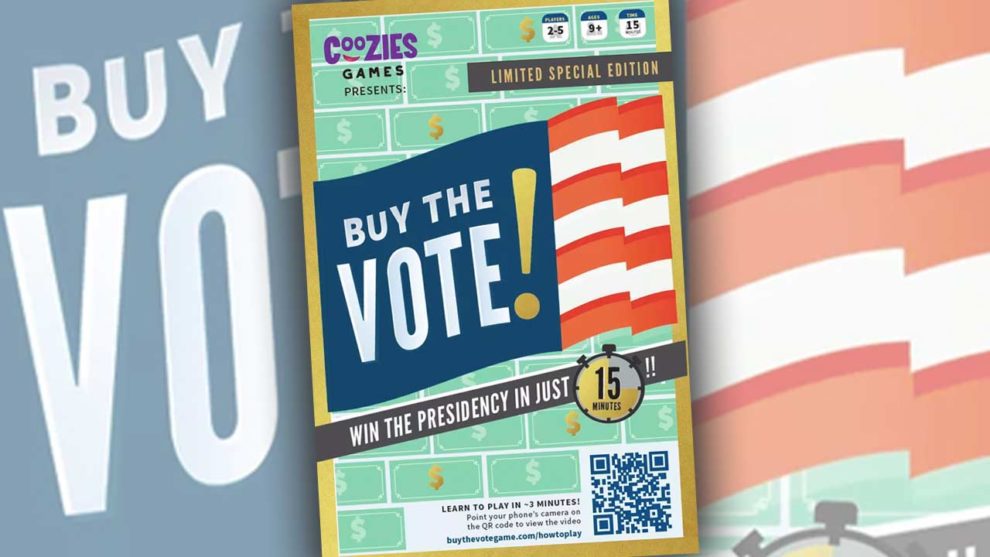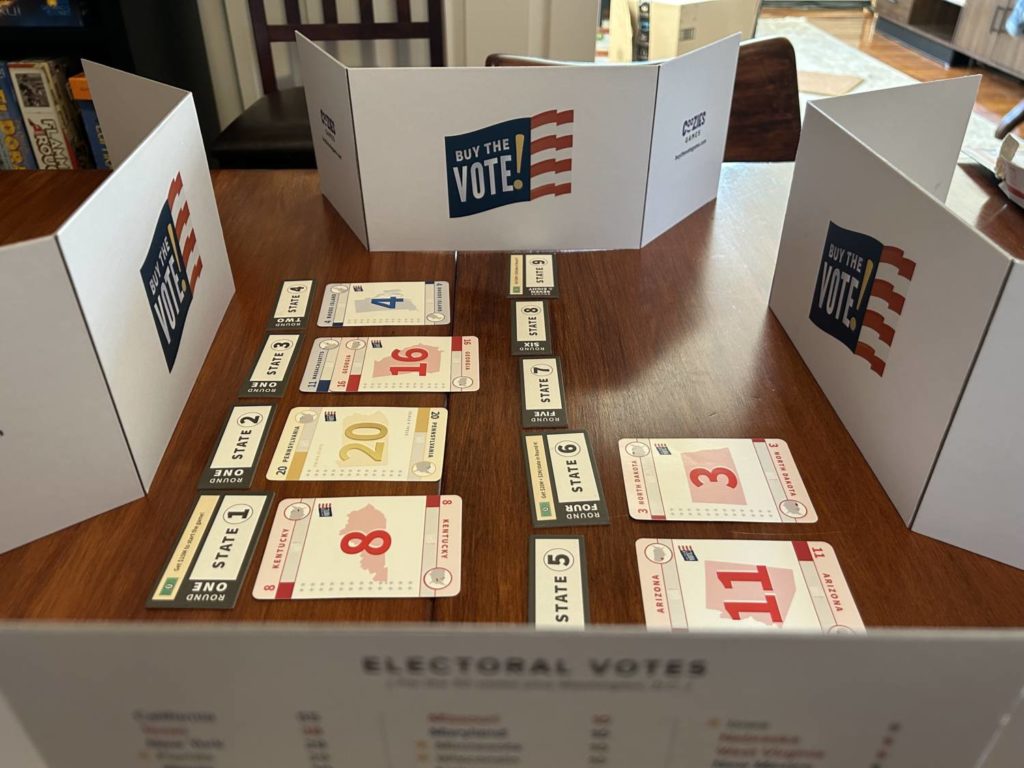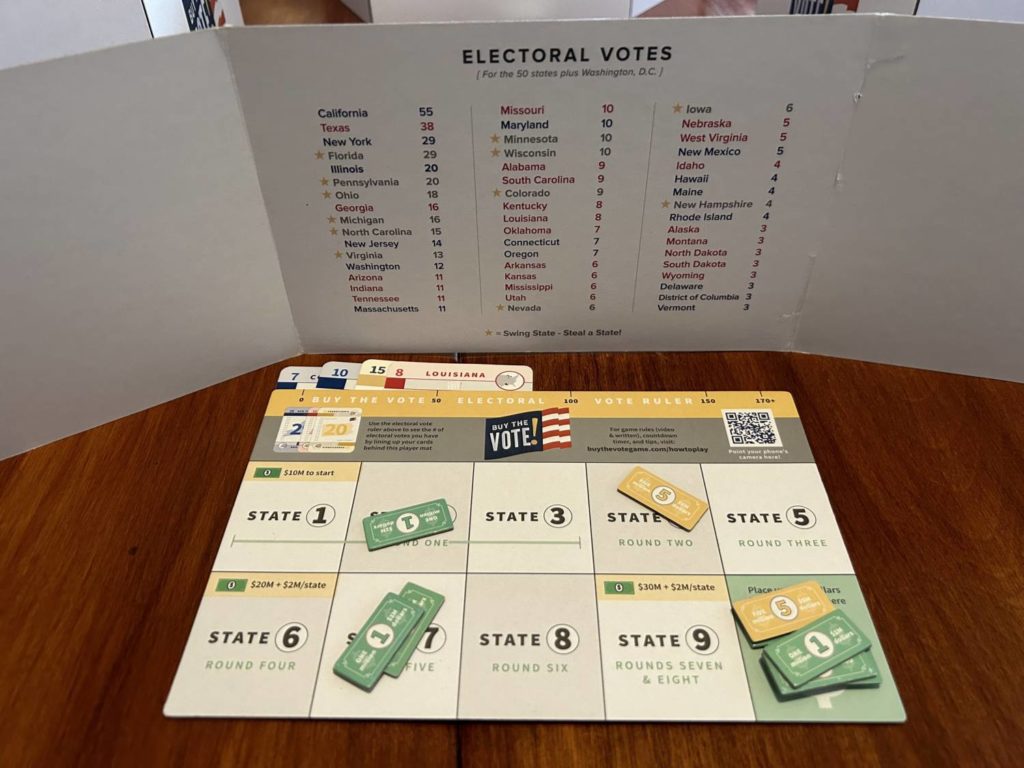Disclosure: Meeple Mountain received a free copy of this product in exchange for an honest, unbiased review. This review is not intended to be an endorsement.
At the far end of any convention lie the tables for the scrappy upstarts who form the beating heart of a hobby pursuit. Some are medium-sized enterprises more familiar to other markets. Others are small publishers with only a title or two to their name. The lifeblood, though, the reason Siberia is worth exploring, is the collection of individuals promoting self-published games.
One of the games I came across this year in the far reaches of PAXU was the Coozies Games release Buy the Vote!. This politically-themed auction game for 2-5 players has you take on the role of a presidential contender from a new political party. Over the course of nine rounds, you allocate campaign funds to different states in an attempt to win over voters and assume the Presidency.
 Election Day
Election Day
As in real life, you become President by winning states. Every state, along with D.C., is represented by a card, the value of which corresponds directly to that state’s number of votes in the Electoral College. South Dakota, for example, is worth 3 points, while California weighs in at a hefty 55. At the beginning of each round, a predetermined number of states are dealt out. For the first round, there are three. For the second, four. For the third, five, and so on, until the last two rounds of nine cards each.
Each player has a board with spaces corresponding to the cards that are dealt out. With privacy screens in place, candidates decide how best to allocate funds. Let’s say Illinois, South Dakota, and Virginia are out in the first round, and I’m interested in Illinois and Virginia. I have an initial warchest of $10 million, which has to last three rounds, so I decide to be a little reserved and spend $2 million in Illinois and $1 million in Virginia. Once everyone has placed their bids, privacy screens are removed and bids are compared.
I was about to say “Here’s where it gets good,” but it already got good. The use of privacy screens for masking the bidding process is a key component of Buy the Vote!. The quiet, frustrated, uncertain private arithmetic of allocating funds. The bubble of tension that engorges as everyone reaches to remove their screen. Eyes swimming across the table in a feeding frenzy, checking to see whether your opponents did outbid you in California. Beautiful, beautiful drama.
Bids are compared. The player with the highest bid takes the card and slots it under their board. If there’s a tie, nobody wins, and the state stays out for the next round, when it will be joined by a second card. Unlike most auction games, you spend what you bid whether you win, lose, or draw. Just because you didn’t win, doesn’t mean you don’t have to pay for all those TV ads.
Let’s talk about finances. Every candidate begins the game with $10 million available. That money has to last you three rounds, at which point every player will receive $20 million plus $2 million per state they’ve already won. A few rounds later, there’s a final influx of funds, again tied in part to the number of states you’ve won.
This is a smart design choice. Not only is it thematic, since more popularity in a greater number of states helps you fundraise, but it also helps keep the table from getting clogged up with low-value cards nobody wants. It’s worth spending $3 million on a low-vote card that will earn you $4 million in fundraising by the time the game is over.
Swing, Swing, Swing from the Tangles of My Heart
The states in the deck are red, blue, and yellow, corresponding to the color of the state as called in the 2020 election. Red and blue are pretty self-explanatory. Yellow cards are swing states, and they are a puckish addition to this design.
Let’s say California comes out in the first round of the game, and some enterprising young candidate puts all $10 million of their starting funds into winning the biggest electoral fish in the pond. Congratulations, you’ve won 20% of the votes you’ll need to win, but it’s probably going to backfire.
Wiping yourself out for anything in Buy the Vote! is risky. If I win the swing state Ohio, for example, I add Ohio to my stack of cards, but I also get to take the most recent card won by another player. That all-in on California player is a sitting duck until the next round of fundraising, when they will also likely receive fewer funds than anyone else. If I win a swing state right now, I’m probably taking California.
Beyond even that, the other stroke of genius in the way swing states work in this design is how it encourages slight overbidding for low-value states. If I win California, it’s in my interest to pick up a buffer zone of states afterwards. It also makes low-value states more appealing. Who’s going to bother you when they win a swing state if all they can get from you is 3 or 4 votes?
 Buy Buy Buy
Buy Buy Buy
I think Buy the Vote! is a terrific design, with a great theme. If you aren’t into politics and you just want a quick, approachable auction game with lots of shouting, Buy the Vote! will scratch that itch. On the other hand, if you’re like me, you can dig into the premise as much as you want. I get a remarkable amount of joy out of picturing the specifics of what each of my bids is going to pay for. “We’re allocating $3 million to Iowa. I want radio spots. Let’s see if we can get a kid with a slight lisp. People love a lisp. We can use that.” You could easily preamble the bidding process by having everyone pitch their party and describe their platform.
I do have my complaints, mostly in the form of two rules I would—and you easily can—jettison. The game tells you to use a 15 minute timer, ending the game after 15 minutes no matter what, but I would ignore that. It doesn’t make thematic sense, for one thing. A better, more thematic way to get a similar effect is to have a round timer. You likely won’t need it, though, unless your group is prone to paralysis. All of my games have moved at a crisp pace, falling within 15-20 minutes each time.
The other issue is thematically apt: One or two players have to reach 270 votes to win. In practice, this means the first place player becomes President and second becomes Vice President, just like the olde days. At 3 or 4 players, that usually works out fine, but at 5 there simply aren’t enough points on the table. This could be a rich area of mechanics interacting in a more demanding and involved game, but for Buy the Vote!, it’s a bit of a hassle. I would encourage sticking to Most Points Wins as a general policy, unless your group wants to do a runoff election.
Sitting down at the Buy the Vote! booth was a complete whim. It was early on the Sunday of the convention. My feet were tired from two full days of conventioneering. I had passed the patriotic booth, boldly emblazoned with the American flag, several times. The vibes, as the kids say, were right. I had no idea it would end up being the best demo experience I had that weekend.
Buy the Vote! is simple, satisfying, and, most importantly, it’s a hell of a lot of fun. If you’re looking for a quick, incredibly social auction game to add to your collection, I can’t recommend it enough.




 Election Day
Election Day Buy Buy Buy
Buy Buy Buy







Add Comment